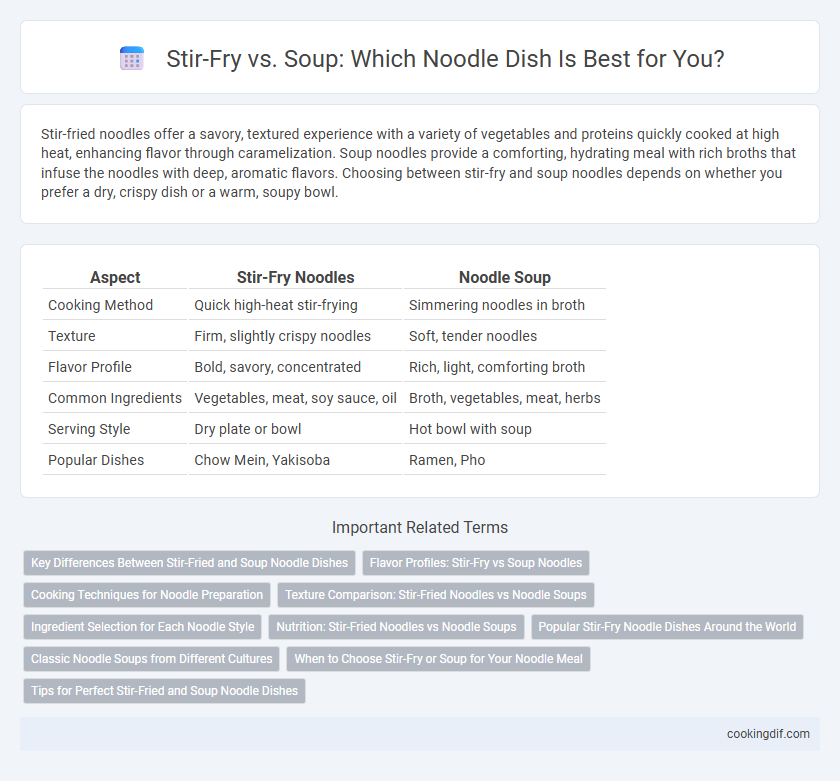Stir-fried noodles offer a savory, textured experience with a variety of vegetables and proteins quickly cooked at high heat, enhancing flavor through caramelization. Soup noodles provide a comforting, hydrating meal with rich broths that infuse the noodles with deep, aromatic flavors. Choosing between stir-fry and soup noodles depends on whether you prefer a dry, crispy dish or a warm, soupy bowl.
Table of Comparison
| Aspect | Stir-Fry Noodles | Noodle Soup |
|---|---|---|
| Cooking Method | Quick high-heat stir-frying | Simmering noodles in broth |
| Texture | Firm, slightly crispy noodles | Soft, tender noodles |
| Flavor Profile | Bold, savory, concentrated | Rich, light, comforting broth |
| Common Ingredients | Vegetables, meat, soy sauce, oil | Broth, vegetables, meat, herbs |
| Serving Style | Dry plate or bowl | Hot bowl with soup |
| Popular Dishes | Chow Mein, Yakisoba | Ramen, Pho |
Key Differences Between Stir-Fried and Soup Noodle Dishes
Stir-fried noodle dishes typically feature noodles cooked at high heat with vegetables, protein, and savory sauces, resulting in a dry, flavorful texture with a slight char. Soup noodle dishes are characterized by noodles immersed in a rich broth, combining ingredients that infuse the soup with depth and warmth, offering a comforting and hydrating experience. The key difference lies in the cooking method and moisture content, with stir-fried noodles emphasizing bold, concentrated flavors, while soup noodles prioritize a balanced, aromatic liquid base.
Flavor Profiles: Stir-Fry vs Soup Noodles
Stir-fry noodles offer a bold, savory flavor profile characterized by caramelized soy sauce, garlic, and spices that create a rich, umami-packed experience. Soup noodles provide a delicate, aromatic broth base enhanced by herbs, bone marrow, or seafood essence, delivering a comforting and layered taste. The texture contrast also influences flavor perception: stir-fried noodles are often chewy with a slightly crispy edge, while soup noodles are tender and infused with broth aromas.
Cooking Techniques for Noodle Preparation
Stir-frying noodles involves high-heat cooking with constant tossing to achieve a desirable chewy texture and caramelized flavor, utilizing ingredients like soy sauce and vegetables for enhanced taste. Soup-based noodle preparation relies on simmering noodles in flavorful broths, which softens the noodles and infuses them with rich, aromatic liquids often featuring stock bases such as chicken or beef. Both methods require precise timing to ensure optimal noodle texture, with stir-frying emphasizing quick cooking and soup preparation focusing on broth composition and simmering duration.
Texture Comparison: Stir-Fried Noodles vs Noodle Soups
Stir-fried noodles offer a distinct chewy texture with slightly crisp edges due to high-heat cooking in a wok, enhancing the noodles' firmness and bite. In contrast, noodle soups provide a softer, more tender texture as the noodles soak in broth, absorbing moisture and flavors. The choice between stir-fried and soup noodles significantly impacts the mouthfeel and overall eating experience.
Ingredient Selection for Each Noodle Style
Stir-fry noodle dishes often feature ingredients that maintain texture and resist sogginess, such as firmer vegetables like bell peppers, carrots, and snap peas, along with proteins like chicken, beef, or tofu. In contrast, noodle soups prioritize tender, water-loving ingredients like leafy greens, mushrooms, and thinly sliced meats that infuse the broth with flavor. Selecting the appropriate noodle type--thicker, chewier noodles for stir-fry and thinner, more delicate noodles for soup--also enhances the overall harmony of each dish.
Nutrition: Stir-Fried Noodles vs Noodle Soups
Stir-fried noodles typically contain higher calorie and fat content due to oil used in cooking, making them a more energy-dense option compared to noodle soups. Noodle soups provide better hydration and often incorporate nutrient-rich broths loaded with vegetables and lean proteins, enhancing vitamin and mineral intake. Choosing between the two depends on dietary goals, with noodle soups favoring lower calories and improved nutrient absorption from broth-based ingredients.
Popular Stir-Fry Noodle Dishes Around the World
Stir-fry noodle dishes showcase vibrant flavors and textures through quick-cooking methods using high heat, resulting in a slightly charred, chewy bite preferred in Asian cuisines such as Chinese Chow Mein, Thai Pad Thai, and Japanese Yakisoba. Unlike noodle soups, stir-fries prioritize concentrated sauces like soy, oyster, or hoisin combined with fresh vegetables, meats, and aromatic spices, providing a dry yet flavorful experience. These globally popular stir-fry noodles underline cultural diversity and culinary innovation by blending traditional ingredients with modern techniques.
Classic Noodle Soups from Different Cultures
Classic noodle soups from different cultures showcase rich broths infused with herbs, spices, and proteins, creating deeply savory and aromatic flavors. Examples include Japanese ramen with its miso or shoyu base, Vietnamese pho with its fragrant star anise and cinnamon broth, and Thai boat noodles featuring a bold mix of spices and beef or pork. Each soup highlights the noodle's ability to absorb complex flavors, contrasting with stir-fried noodle dishes that emphasize texture and concentrated seasoning.
When to Choose Stir-Fry or Soup for Your Noodle Meal
Choose stir-fry noodles when craving a quick, flavorful dish with a crispy texture and vibrant vegetables, ideal for warm weather or light meals. Opt for noodle soup when seeking comfort, warmth, and hydration, perfect for colder days or when needing a soothing, broth-based meal. Consider nutritional needs and mood; stir-fry offers concentrated nutrients and bold flavors, while soup provides hydration and gentle digestion.
Tips for Perfect Stir-Fried and Soup Noodle Dishes
For perfect stir-fried noodle dishes, use high heat and quick cooking to retain the noodles' texture and prevent sogginess, while incorporating fresh vegetables and proteins like chicken or shrimp for balanced flavor. When preparing soup noodle dishes, simmer broth slowly with ingredients such as beef bones, ginger, and star anise to develop rich, aromatic depth, and add noodles just before serving to maintain their firmness. Proper timing and ingredient quality ensure vibrant, authentic noodle experiences in both stir-fried and soup variations.
Stir-fry vs soup for noodle dish Infographic

 cookingdif.com
cookingdif.com